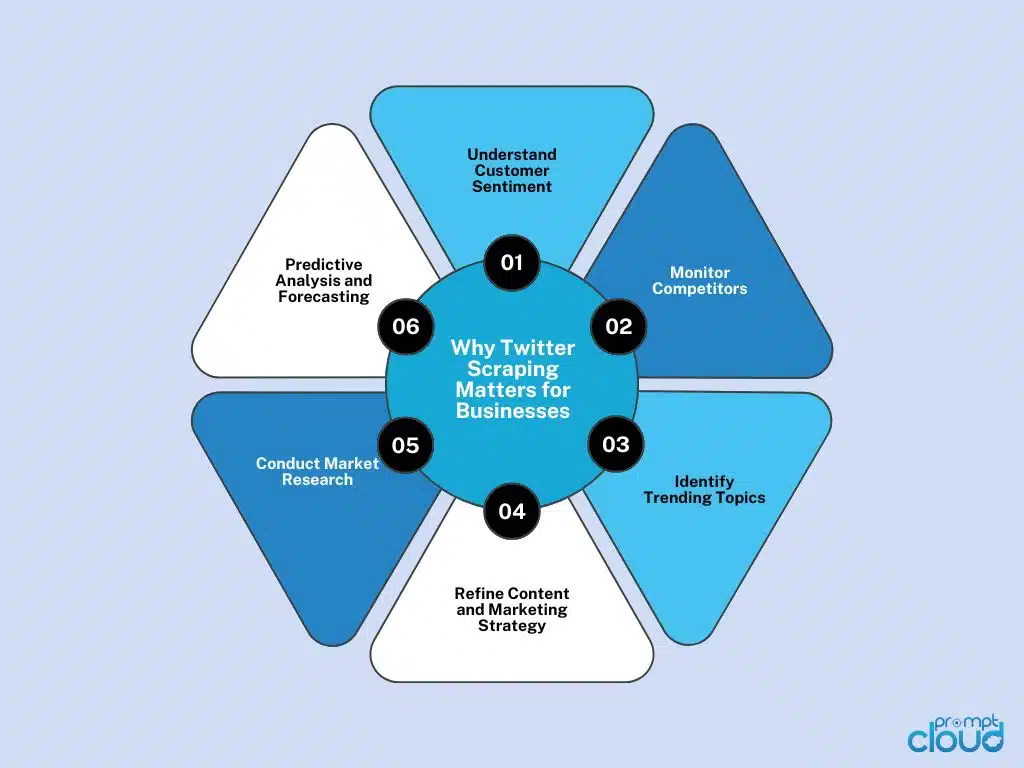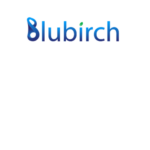
In today’s digital landscape, Twitter (now rebranded as X.com) remains one of the most dynamic platforms for real-time communication, public sentiment, and trend discovery. With its constant stream of user-generated content, Twitter is a goldmine for businesses seeking actionable insights. By using a Twitter scraper, brands can efficiently gather data to monitor competitors, understand customer opinions, track emerging trends, and refine their marketing strategies.
This guide will take you through the benefits of Twitter scraping, how a Twitter scraper can support your business objectives, and best practices for leveraging Python to extract relevant Twitter data. PromptCloud’s expertise in data scraping can help streamline this process, ensuring accurate and compliant Twitter data collection tailored to your needs.
Why Twitter Scraping Matters for Businesses?
With millions of tweets posted daily, Twitter offers a pulse on public opinion, market trends, and competitive activities. Businesses using a Twitter scraper can tap into these conversations to gain insights that were once labor-intensive to obtain. Twitter scraping allows brands to:

- Understand Customer Sentiment:
A Twitter scraper can help you track mentions of your brand and product, as well as customer sentiment. Analyzing this sentiment provides insight into what customers love, dislike, or expect from your brand, allowing you to respond effectively.
- Monitor Competitors:
Twitter scraping enables businesses to observe competitors’ activity, customer interactions, and trending content. A Twitter scraper can capture competitor engagement rates, customer complaints, and popular tweets, offering insights into their strategy and areas where you can differentiate.
- Identify Trending Topics:
Twitter is often the birthplace of viral content and emerging trends. Using a Twitter scraper, brands can track trending hashtags and keywords to stay ahead of industry shifts and incorporate timely trends into their content strategies.
- Refine Content and Marketing Strategy:
A Twitter scraper provides data on what type of content garners high engagement, helping businesses refine their own content strategies. Brands can analyze which tweets, images, or videos attract the most interactions, then use that data to create content that resonates with their audience.
- Conduct Market Research:
Twitter is an excellent resource for understanding public opinion on a wide range of topics. Whether you’re launching a new product or testing a campaign concept, Twitter scraping can help gather public responses, ensuring that decisions are data-driven.
How Twitter Scraping Works?
A Twitter scraper is essentially a tool or code that automates the extraction of data from Twitter pages. With the right approach and Python’s extensive libraries, Twitter scraping can provide an array of valuable data points, including:
- Tweet Content: Text of the tweet, which can be analyzed for keywords, hashtags, and sentiment.
- User Data: Follower count, bio, and profile information, helping to identify influencers and active customers.
- Engagement Metrics: Likes, retweets, replies, and quote counts, which reveal content popularity and engagement.
- Hashtags and Keywords: Trending hashtags and commonly used keywords, useful for tracking public opinion and staying on top of industry trends.
- Timestamp: Date and time of each tweet, providing insights into peak engagement periods and content timing.
Python, along with PromptCloud’s Twitter scraping expertise, allows brands to collect this data efficiently and accurately.
How to Build a Twitter Scraper using Python?
Python’s versatility and robust library ecosystem make it an excellent language for building a Twitter scraper. With libraries like Tweepy, BeautifulSoup, and Selenium, you can automate Twitter scraping while customizing it to meet your specific data needs.
1. Using the Tweepy Library for API-Based Scraping
The official Twitter API provides structured access to tweet data, user information, and engagement metrics. Tweepy is a popular Python library that makes it easy to access Twitter’s API. With Tweepy, you can set up a Twitter scraper that captures data within Twitter’s usage limits and complies with platform guidelines.
2. Web Scraping with BeautifulSoup and Selenium
For brands looking to bypass API restrictions or gather additional page-specific data, web scraping libraries like BeautifulSoup and Selenium can serve as effective alternatives. A web-based Twitter scraper can gather public data directly from the Twitter website, though it requires careful attention to platform compliance.
With Selenium, brands can build a more versatile Twitter scraper, even accessing dynamically loaded tweets by scrolling. However, it requires careful setup and regular adjustments to account for Twitter’s HTML structure changes.
Leveraging PromptCloud’s Twitter Scraper Expertise
Using a Twitter scraper requires technical knowledge, compliance considerations, and constant adjustments to keep up with platform changes. For businesses that want to focus on actionable insights rather than the technicalities of data scraping, PromptCloud offers customized Twitter scraping services.
Here’s how PromptCloud enhances your Twitter scraping efforts:

- Data Accuracy and Reliability: PromptCloud’s Twitter scraper solutions ensure data accuracy by continuously monitoring changes in Twitter’s structure and optimizing scraping methodologies. This accuracy ensures that your data is reliable and ready for analysis.
- Scalability for Large-Scale Data Needs: PromptCloud offers scalable Twitter scraping solutions that can accommodate both small-scale research and large-scale data requirements. Whether you need daily data updates or a one-time collection, PromptCloud can adapt to your brand’s needs.
- Customizable Solutions: Every business has unique data needs. PromptCloud’s Twitter scraper can be tailored to capture specific data points, such as hashtags, user engagement, or timestamps, ensuring that you’re gathering the information most relevant to your strategy.
- Compliance and Data Privacy: Navigating Twitter’s data collection policies and staying compliant can be complex. PromptCloud’s professional Twitter scraper solutions ensure that data is collected responsibly and ethically, allowing your brand to avoid compliance issues.
How to Leverage Twitter Scraping Data for Strategic Decisions?
A Twitter scraper is a powerful tool, but its real value lies in the insights you can extract from the data. Here’s how to turn Twitter scraping data into actionable strategies:
1. Optimize Brand Messaging
By analyzing tweets that mention your brand, products, or industry, you can identify common themes, complaints, and praises. This data can help refine brand messaging to better align with customer expectations, ultimately improving engagement and brand loyalty.
2. Enhance Product Development
Product feedback is abundant on Twitter, whether it’s from loyal customers or potential buyers. A Twitter scraper can capture this feedback, allowing your product development team to address specific needs or complaints. This direct line of communication helps ensure that product improvements align with customer desires.
3. Refine Content Strategy
Using a Twitter scraper to analyze which types of tweets gain the most engagement enables you to refine your content strategy. For instance, if you notice that users engage more with visual content or specific hashtags, you can incorporate similar elements into your own social media posts.
4. Stay Ahead of Industry Trends
Tracking trending hashtags, topics, and conversations gives your brand the ability to adapt to changes quickly. By staying updated with a Twitter scraper, brands can adjust their offerings or messaging to match the latest industry trends, ensuring that they remain relevant and appealing to their audience.
5. Monitor and Improve Customer Service
Many customers use Twitter to express concerns, ask questions, or leave feedback. A Twitter scraper helps monitor these interactions, allowing your customer service team to respond promptly and effectively. This proactive approach enhances customer satisfaction and demonstrates your brand’s commitment to addressing user concerns.
Conclusion
A well-executed Twitter scraping strategy can provide valuable insights that support customer understanding, brand differentiation, and real-time responsiveness. By using Python and the right tools, brands can build a powerful Twitter scraper capable of gathering meaningful data. However, for businesses focused on efficient, scalable, and compliant data collection, partnering with a trusted provider like PromptCloud can make all the difference.With PromptCloud’s expertise in Twitter scraping, your brand gains access to accurate, actionable data that informs strategy and positions you ahead of competitors. Whether you’re looking to refine messaging, improve products, or enhance customer engagement, PromptCloud’s Twitter scraper solutions can unlock the insights you need to grow. Schedule a demo with our team to learn how social media scraping can benefit your business.

















































